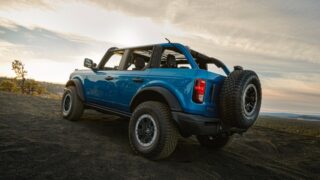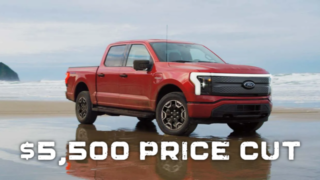SIX STUDENTS, THREE MONTHS, 100,000 APPS: FORD EMBRACES MOBILE APP INNOVATION FOR SYNC
- Ford enlisted students from the University of Michigan-Dearborn for first use of new SYNC application programming interface (API) to spur innovation around future of in-car voice-controlled mobile apps
- Six students were granted use of Ford’s Developers’ License, becoming world’s first SYNC app developers, creating two SYNC-enabled mobile applications using SYNC APIs
- The SYNC API will facilitate development of SYNC-enabled versions of existing mobile apps, plus introduce new pathways for developers in creation of unique automotive apps
- Further beta testing with trusted partners expected to lead to developer community release next year
FACT SHEET: Reducing Driver Distractions
DEARBORN, Mich., Dec. 17, 2009 – When Ford Motor Company began researching ways to adapt Smartphone mobile apps for in-car use through voice control of its popular SYNC® communications system, the company first turned to the nearby University of Michigan-Dearborn campus to spur innovative ideas around “what’s next” for the connected car experience.
There, Ford enlisted the help of six computer science students, working with their professors to devise an extracurricular project that would net the young programmers invaluable real-world experience. It would also give Ford an education on the open software community, which was what the company wanted in order to take SYNC to the next level.
“When we started planning for mobile app functionality on SYNC, we knew we had to think and act with the ‘start-up’ mentality,” said K. Venkatesh Prasad, technical leader for Infotronics, Ford research and advanced engineering. “The explosive growth in apps comes from community-created development, software geeks chatting about code on social media sites, open collaboration. That’s the genesis of app innovation, and that’s the spirit we wanted to capture for SYNC.”
Back to school
To gain outside perspective on the app marketplace, the students headed for the same place millions of SYNC users visit every day: the iPhone App Store. With more than 100,000 applications created in just two years, explosive growth fueled by a spirit of “open innovation” has made the App Store an unprecedented success.
The initial task: winnowing the roughly 100,000 active App Store apps down to those that would be relevant for in-car use. The young developers would then be asked to modify the software to work with SYNC, using the vehicle buttons, displays and voice prompts to control the mobile app. And they had three months during which to work.
Ford was already working on an internal proof-of-concept application programming interface called “SYNCLink,” allowing connectivity between Smartphone mobile applications and the vehicle interface. This API permitted access to the automotive interface – buttons, voice prompts and vehicle displays – that would be needed to make the software work.
To gain access to the SYNC API in development, the students became the first ever to sign Ford’s new SYNC Developers’ License, in effect making them the only six mobile app developers in the world licensed to use the SYNC API for in-vehicle applications. Not only were the agreements drafted in a remarkably short time, but they marked an unprecedented release of proprietary technology by an automaker into the open source community.
“Basically, Ford knew that to provide the most value for its SYNC users and customers, the company had to let go of the reins a little bit,” explains Prasad. “If you give the open source community the opportunity, they’ll almost always do the right thing. For us to do the right thing, we had to trust this open development model in a way that’s not easy for a large company to do.”
Research, rewriting and restarting
Once the students had narrowed down the available apps to those most relevant for in-car use, the next hurdle was gaining access to the source code behind the apps. Legal restrictions, extensive developer agreements and the short timeline soon forced a reality check: None of the readily available open-source software was applicable to the in-vehicle scenario. So the students decided to scrap the initial plan to modify an existing app, and instead collaborate on their own applications for SYNC – built from scratch.
The students sorted through more than 100 different concepts with the Ford API development team, finally narrowing their focus to two areas; audio infotainment (internet music, news and talk show streaming sites) and GPS location-based navigation services. The resulting apps included a mash-up of infotainment features codenamed “SYNCcast” and “FollowMe.” SYNCcast lets users enjoy internet radio in the vehicle. The navigation app called “FollowMe” allows two or more friends to follow a lead vehicle to a location without the need to physically follow each other, thanks to GPS turn-by-turn directions transmitted from the leader to the followers and read aloud to the drivers.
“These students also took the initiative to research automotive safety standards through the National Highway Traffic Safety Administration and the Department of Transportation,” said Prasad. “Completely on their own, they recognized their apps needed to consider the unique requirements of the in-car telematics environment.”
Next steps
The work done through Ford’s University of Michigan-Dearborn collaboration is expected to lead to a planned 2010 release of the full open API first to established, trusted developer partners. By working initially with trusted partners, Ford will be able to ensure any SYNC-enabled apps conform to vehicle telematics standards for safety and security, following the company’s guidelines for in-car connectivity to keep driver’s hands on the wheel and eyes on the road. At the same time, an open API strategy will help add the creativity and excitement present in the open development arena.
“By embracing the open innovation community, we’re able to let creativity guide us,” said Prasad. “We can pursue the apps that lead to the most value for our customers and, since anything approved for SYNC will have to meet our telematics standards, we can help ensure safety and usability goals are met.”
Ford is joining millions of its customers in embracing the app marketplace. Studies show what was a nonexistent niche just three years ago is expected to blossom into a $4 billion industry by 2012. The App Store, run by Apple, is one of dozens of application stores, and already boasts more than 100,000 mobile apps and over 2 billion downloads. Similar sites serving other mobile operating systems, like Google’s Android and RIM’s BlackBerry, are experiencing similar explosive growth. Ford and SYNC will answer the consumer demand by offering the only connectivity platform available for drivers to safely manage their mobile applications in the car using voice commands and buttons on the steering wheel.
“Imagine being able to access your favorite Internet radio services in your vehicle, all by voice command,” said Doug VanDagens, director of Ford’s Connected Services Solutions Organization. “Think about how excited drivers will be when they can access their most recent social networking messages and have them read to them by our text-to-voice engine.”
Ford’s app ecosystem
With the development of the API, Ford adds a third category to its ecosystem of available apps for SYNC, continuing the company’s trend of introducing new features and capabilities to SYNC each year since its introduction.
“Ford is leveraging SYNC to find more ways to affordably connect users to the devices, services, content, data and now, the applications they want and use,” said VanDagens. “The result will further blur the line between consumers’ vehicles and their mobile devices as Ford moves toward its goal of seamless in-vehicle communications integration.”
First, in 2008, Ford introduced “Built In” or embedded apps on the SYNC system inside the car, including 911 Assist and Vehicle Health Report. These applications were added features, at no additional cost to customers, and became available to download and install for existing SYNC owners through software downloads or during engine calibration while visiting a local Ford dealer.
Second, in early 2009, Ford created the Service Delivery Network (SDN), a plug-and-play architecture connecting six data centers for real-time information and leveraging a customer’s Bluetooth-paired mobile phone for data-over-voice exchanges, thus adding “Beamed In” apps to the SYNC ecosystem. Ford SYNC customers with the Traffic, Directions & Information (TDI) app can now access real-time turn-by-turn driving directions, traffic, business searches, and favorite news, sports and weather without the need for a full on-board navigation system. Once again, Ford added this new capability without added cost to the customer, providing the TDI app as a free service for the first three years of 2010 model year vehicle ownership. All customers had to do was visit www.syncmyride.com for a free download of the app, which was then installed through the vehicle’s USB port while parked.
With the development of the SYNC API, the potential now exists for the third “Brought In” category, incorporating mobile apps as part of the SYNC app ecosystem.
###
About Ford Motor Company
Ford Motor Company, a global automotive industry leader based in Dearborn, Mich., manufactures or distributes automobiles across six continents. With about 200,000 employees and about 90 plants worldwide, the company’s automotive brands include Ford, Lincoln, Mercury and Volvo. The company provides financial services through Ford Motor Credit Company. For more information regarding Ford’s products, please visit www.ford.com.





